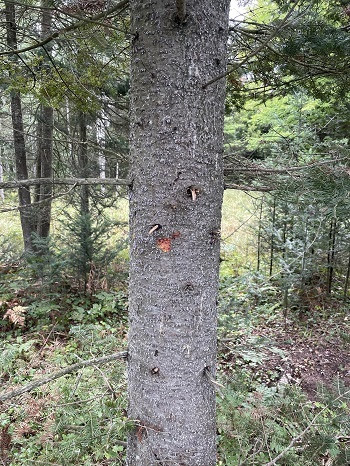MI DNR: It’s time to spray trees to combat spruce budworm defoliation


Michigan Department of Natural Resources forest health experts anticipate widespread defoliation from spruce budworms to continue across much of the Upper Peninsula in the weeks to come.Spruce budworm caterpillars, like the one shown here, feed on new growth of balsam fir and spruce trees, causing defoliation.
Robert Heyd, DNR Forest Health Management Program leader, toured the region this past week. He said the trees have shed their bud caps and spruce budworm larvae are feeding on the young spruce and fir shoots.
“Homeowners interested in protecting landscape spruce or fir from defoliation this year should spray their trees now,” Heyd said.
Products with Bt, a safe, soil-dwelling bacterium that is toxic to many insect pests, are recommended for spraying. Only one application is necessary.
“As the budworm larvae grow, they will cause increasing levels of defoliation,” Heyd said. “Clipped needles will turn brown later in June, showing this year’s affected areas.”
Targeted trees
Balsam fir is most severely damaged by budworms. During Michigan’s last outbreak, two-thirds of the balsam fir and roughly four in 10 white spruces were killed.
Budworms also feed on black spruce, tamarack, pine and hemlock trees when they are in stands with balsam fir or white spruce, but these species generally suffer less damage.
Spruce budworm caterpillar damage is shown on new tree growth.Repeated budworm defoliation can cause top kill and tree mortality in older and stressed trees. Balsam fir older than 60 years and spruce over 70 offer prime infestation opportunities. Younger trees infested with spruce budworms lose much of their new growth, but generally survive. Stands defoliated for more than a year can have heavy mortality or may have trees with dead tops.
Damaging history
Spruce budworm is one of the most destructive native insects in northern spruce and fir forests of the eastern United States and Canada. In 2014, many areas in the western U.P. were defoliated for the first time, while other areas had been hit off and on for several years. Spruce budworm damage was much more widespread last year and varied throughout the region.
Periodic budworm outbreaks are part of the natural maturation cycle of balsam fir and white spruce. Every 30 to 50 years, large-scale outbreaks cause widespread top kill and tree mortality.
The last outbreak in Michigan started in the Upper Peninsula in the late 1960s and ended in the early ’80s. During that episode, spruce and fir tree mortality was mapped across 519,000 acres in Michigan.
Check out more information on forest health issues, including a Frequently Asked Questions page on the spruce budworm.
Contact: Bob Heyd, 906-228-6561, ext. 3023 or John Pepin, 906-226-1352






